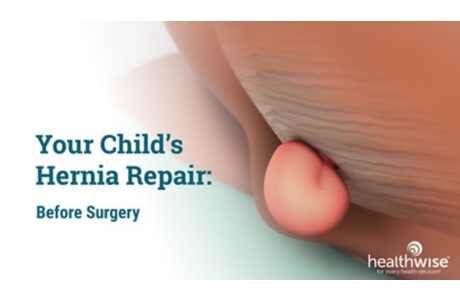Common Types of Hernias
Topic Overview
What is a hernia?
A hernia is a bulge caused by tissue pushing through the wall of muscle that’s holding it in. Most hernias are abdominal hernias. This means they happen in the belly and groin areas.
You may have a hernia if you can feel a soft lump in your belly or groin or in a scar where you had surgery in the past. The lump may go away when you press on it or lie down. It may be painful, especially when you cough, bend over, or lift something heavy.
Types of hernias include:
- Inguinal hernia.
- Femoral hernia.
- Umbilical hernia.
- Incisional hernia.
- Epigastric hernia.
- Hiatal hernia.
Health Tools
Health Tools help you make wise health decisions or take action to improve your health.
Inguinal Hernia
An inguinal hernia (say “IN-gwuh-nul HER-nee-uh”) occurs when tissue pushes through a weak spot in the groin muscle.
Most inguinal hernias happen because an opening in the muscle wall does not close before birth as it should. This leaves a weak area in the belly muscle. When tissue pushes through the muscle, it creates a bulge.
The main symptom of an inguinal hernia is a bulge in the groin or scrotum. It often feels like a round lump. The bulge may hurt or burn. It may form over a period of weeks or months. Or the bulge may appear all of a sudden after you lift heavy weights, cough, strain, or laugh.
If you have an inguinal hernia, it won’t heal on its own. Surgery is the only way to treat it. To learn more, see the topic Inguinal Hernia.
Femoral Hernia
A femoral hernia (say “FEH-muh-rull HER-nee-uh”) occurs when tissue bulges from the lower belly into the upper thigh, just below the groin crease. Femoral hernias occur more often in women than in men.
Pain from a femoral hernia is usually felt in the groin area. It is sometimes mistaken for an inguinal hernia.
A femoral hernia can be hard to diagnose. The hernia may be too small for your doctor to feel during a physical exam. You may need other tests. Often a femoral hernia is found when part of the intestine is trapped and blood supply to the tissue is cut off. This is called a strangulated hernia. It requires emergency surgery.
Umbilical Hernia
An umbilical hernia occurs when intestine, fat, or fluid pushes through a weak spot in the belly. This causes a bulge near the belly button, or navel.
In children
Umbilical hernias often occur in infants. Most of the time, they close on their own by the time a baby is 1 year old. But sometimes surgery is needed. To learn more about hernias in children, see the topic Umbilical Hernia in Children.
In adults
Umbilical hernias can also occur in adults. They can happen in people who have health problems that create pressure in the belly, such as being overweight, being pregnant, or having too much fluid in the belly (ascites). Other health problems can also lead to umbilical hernia. These include a chronic cough, chronic constipation, and problems urinating because of an oversized prostate gland. Most of the time, a doctor can diagnose an umbilical hernia during a physical exam.
An umbilical hernia tends to get bigger over time. You may need surgery to treat it, especially if it gets bigger or becomes painful.
Without treatment, there is a risk of a strangulated hernia, which means that part of the intestine or fat is trapped and blood supply to the tissue is cut off. This can be very painful. It requires emergency surgery. Call your doctor right away if the bulge becomes swollen, painful, tender, or discolored.
Incisional Hernia
An incisional hernia can occur after surgery in the belly. It can happen months or even years after surgery. Most of the time, it occurs along a vertical (up and down) incision. This type of hernia can occur in people who:
- Are very overweight.
- Are older.
- Have used steroid medicines.
- Have had lung problems after surgery.
- Have had a wound infection after surgery or have had more than one surgery using the same incision.
An incisional hernia can be large and painful. Talk with your doctor about your treatment choices.
Epigastric Hernia
An epigastric hernia (say “eh-pih-GAS-trik HER-nee-uh”) occurs when fat pushes through a weak part of the belly wall. It occurs in the middle of the belly between the breastbone and the belly button, or navel. Most of the time, these hernias are small. You can have more than one at a time.
Epigastric hernias often have no symptoms. But they can cause pain in the upper belly. You may need surgery to repair an epigastric hernia. Talk with your doctor about your treatment choices.
Hiatal Hernia
A hiatal hernia (say “hi-AY-tul HER-nee-uh”) is different from other types of hernias, because it involves the stomach instead of the intestine. It occurs when part of your stomach bulges up through your diaphragm and into your chest. The diaphragm is a sheet of muscle that separates your belly from your chest. You can’t feel a hiatal hernia or see a bulge.
Most people with a hiatal hernia have no symptoms. But one symptom you may have is heartburn. If you often have symptoms, or if they are very bad, you may also have gastroesophageal reflux disease (GERD). A hiatal hernia can lead to GERD. It’s common to have both problems at the same time.
If you don’t have symptoms, you don’t need treatment. But if your symptoms bother you, your doctor may suggest lifestyle changes or medicines. To learn more, see the topic Hiatal Hernia.
Current as of: November 7, 2018
Author: Healthwise Staff
Medical Review:Kathleen Romito, MD – Family Medicine & Adam Husney, MD – Family Medicine & Kenneth Bark, MD – General Surgery, Colon and Rectal Surgery
This information does not replace the advice of a doctor. Healthwise, Incorporated, disclaims any warranty or liability for your use of this information. Your use of this information means that you agree to the Terms of Use. Learn how we develop our content.





